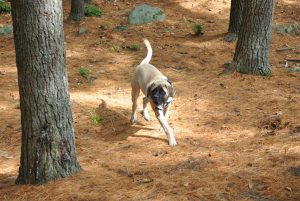One of the oldest and largest dog breeds, the English Mastiff is a guard dog that can be surprisingly gentle. This dog is not for the faint-hearted though. A breed this big needs a big home and has a big appetite too.
History of Breed: There is some confusion over the Mastiff breed and the term ‘mastiff’ to describe a type of dog. The mastiff type, also known as ‘molosser’, is a term used to describe a collection of large dog breeds that originate from a common ancestor from the Molossia area of ancient Epirus. The Mastiff breed, also known as the English Mastiff or Old English Mastiff, is one of these breeds. Other mastiff type breeds include the Dogue de Bordeaux, Boxer, Bulldog and Bullmastiff. Originally used for bull and bear baiting and as a fighting dog, numbers of the Mastiff declined once these ‘sports’ were outlawed in 1835. Following World War Two, when numbers had fallen to just 14 in Britain, breeders had to import dogs from America to increase the breeding stock. The breed’s courage and size make them a great guard dog.
Life Expectancy: Under ten years.
Size: A large dog with a height range of 70-77cm and a weight range of 79-86kg.
Features: The English Mastiff gives an impression of well-built power and strength and can be something of an immovable object if it puts its mind to it! It has a large head and a broad, deep body on wide, straight, muscular legs. Whilst size is desirable, it is more important for a dog to have soundness and quality. The head is square with raised brows and a flat forehead. The muzzle is short and broad under the eyes, ending in a broad nose too. The eyes are hazel brown, preferably dark, and the ears are small, thin and set wide apart and high on the skull. The coat is short and close-lying, though coarse over the neck and shoulders. It comes in apricot, fawn or brindle with a black mask around the eyes, black ears, muzzle and nose.
Energy Levels/Exercise Required: Although a large dog, the English Mastiff does not require huge amounts on exercise. In fact, owners should limit exercise during the first two years of rapid growth to prevent bone problems later in life. A fine balance needs striking between ensuring the dog doesn’t develop lazy habits and protecting growth. Gentle exercise, no stairs and no jumping up to or down from heights is best in the early years. Once the rapid growth period is over, regular exercise is essential to maintain health.
Potential Health Problems: As mentioned above, English Mastiff owners must be particularly careful during the puppy’s period of rapid growth. In large, heavy breeds of dog, the puppy can grow and gain weight excessively quickly. The growth plates must not be under extra strain from exercising at this time as this can cause bone and joint problems later in life. Gilpa Kennel caters specifically to large and giant breeds of dog. It has large biscuit pieces to suit the larger mouth size of a big breed and also contains a higher level of bone and joint complex to support the skeleton of the dog under extra strain. A good alternative is Dr John Gold, as this has a level of protein appropriate for a large dog and also benefits from dietary supplements that will help keep a Mastiff in good shape over their life.
Other health problems include hip dysplasia and gastric torsion, both common problems in large, deep-chested breeds. When puppies are nursing, they can be at risk of suffocation and crushing by the weight of the mother, so a proper whelping box and extra vigilance are essential at this time. It is also a good idea for Mastiffs to sleep on a soft, comfortable surface to prevent the formation of calluses, arthritis and hygroma, an acute imflammation.
Temperament: The English Mastiff has lost the aggression of its fighting past, but retains its courage and bravery. It is loyal, calm and affectionate to its owners. It is neither friendly nor aggressive to strangers, but rather indifferent and a good guard dog. The breed requires an experienced owner to train and handle it.
Child Friendly/Family Dog: As a very large dog, the Mastiff requires careful monitoring with very small children, who could be at risk of crushing if they get between the dog and a wall or door. Their temperament makes them a good family dog for a family with older children. They are happiest in a large house with plenty of room to stretch out, but do not require lots of outdoor space.
Likes: Room to spread out, affection and attention.
Dislikes: Solitude, confined spaces.
This breed profile uses information from The Kennel Club, Wikipedia and Dorling Kindersley’s ‘The Complete Dog Breed Book’.



